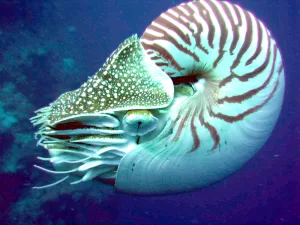Description
Madagascar Cymatoceras Nautilus
- Cymatoceras sp.
- Jurassic/Cretaceous Age
- Mahajanga, Madagascar
- Each Nautilus was hand-selected to insure we only offer you the best quality specimens available. This beautiful Nautilus has been cut in half and fully polished to reveal all of the interior chambers and the siphuncle. Each side of the pair measures 3.18″ wide. You will receive both halves.
- More Ammonites & Goniatites for Sale
Madagascar Cymatoceras Nautilus
WHAT ARE THEY?
Nautilus fossils are the fossilized remains of ancient marine molluscs, a part of the cephalopod family along with octopuses, squid, and extinct ammonites. Nautilus fossils are prized for their stunning external coiled, spiral-patterned shells and colorful chambers. They are a large and diverse group of marine cephalopods (Mollusca) belonging to the subclass Nautiloidea.
HOW OLD ARE THEY?
They first appeared began in the Late Cambrian and are represented today by the living Nautilus and Allonautilus.
Nautiloids flourished during the early Paleozoic era, where they constituted the main predatory animals. They developed an extraordinary diversity of shell shapes and forms. Some 2,500 species of fossil nautiloids are known, but only a handful of species survive to the present day. Nautiloids are among the group of animals known as cephalopods, an advanced class of mollusks. The group also includes ammonoids, belemnites and modern coleoids such as octopus and squid. Traditionally, the most common classification of the cephalopods has been a three-fold division (by Bather, 1888), into the nautiloids, ammonoids, and coleoids.
WHAT ARE THE CHAMBERS AND SIPHUNCLES?
The septa are perforated by the siphuncle, which runs through each of the internal chambers of the shell. Surrounding the fleshy tube of the siphuncle are structures made of aragonite (a polymorph of calcium carbonate. During fossilization it is often re-crystalized to calcite, a more stable form of calcium carbonate [CaCO3]): septal necks and connecting rings.
Some of the earlier nautiloids deposited calcium carbonate in the empty chambers (called cameral deposits) or within the siphuncle (endosiphuncular deposits. This process may have been connected with controlling buoyancy. The nature of the siphuncle and its position within the shell are important in classifying nautiloids. The siphuncle position can help distinguish them from ammonoids (the siphuncle is on the shell periphery in most ammonoids whereas it runs through the center of the chambers in most nautiloids)










